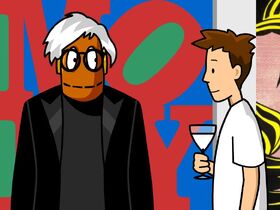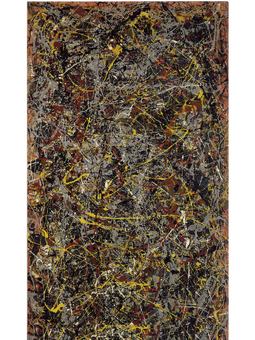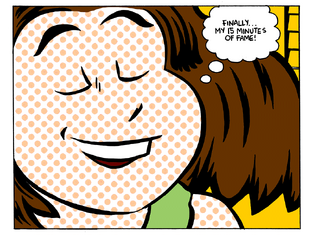| Pop Art | |||
|---|---|---|---|
 | |||
| Airdate | November 29, 2011 | ||
| Curriculum | Arts & Music | ||
Pop Art is a BrainPOP movie that was launched or aired on November 29, 2011.
Summary[]
Tim is at an art gallery and looking at some of Moby's paintings made by himself. Tim finds him dressed as Andy Warhol and asks him that if he painted anything besides self-portraits. Moby tells Tim to look at the painting that has Rita on it which happens to be pop art. Tim says he stand corrected. Tim answers a letter and discusses about pop art with Moby.
Appearances[]
Transcript[]
Quiz[]
- Pop Art/Quiz
Quotes[]
Trivia[]
- In the end of the movie, Tim mentions that they were at a Metropolitan Gallery. In the United Kingdom version, he mentions a Leeds Metropolitan Gallery.
Related Readings[]
Trivia

- Roy Lichtenstein painted his first comic-book panel—1961’s Look, Mickey—after being challenged by his young son. Pointing to a Mickey Mouse comic he was reading, the boy told his father, “I bet you can’t paint as good as that!”
- In 1964, an executive at Campbell’s Soup wrote a letter to Andy Warhol. It said that the painter’s images of soup cans “evoked a great deal of interest” at the company, wished him “continued success and good fortune,” and offered him several free cases of tomato soup.
- On May 15, 1969, students at Yale University were baffled to find an enormous Claes Oldenburg “monument”—a 24-foot-tall, 3,500-pound tube of lipstick mounted on tank treads —suddenly installed on a large public plaza on campus. Oldenburg and a small group of students, faculty, and alumni secretly collaborated on the project, and while its appearance caused confusion at first, it quickly became very popular. The lipstick was later moved to a smaller courtyard, where it’s still on display.
- Pop artist Jasper Johns played himself on a 1999 episode of The Simpsons. Spoofing the idea that Johns “stole” ideas from other artists, he’s portrayed as a habitual thief, making off with food, lightbulbs, a motorboat, and even one of Marge Simpson’s original paintings!
- The word “pop,” as relating to pop art, first appeared in British artist Eduardo Paolozzi’s 1947 collage, I was a Rich Man’s Plaything. It appears in a puff of smoke emerging from the barrel of a handgun.
- The first museum exhibition to feature pop art was held in Pasadena, CA, in 1962. It was called “New Painting of Common Objects,” and featured works by six artists, including Warhol and Lichtenstein.
Quotables

“[Pop Art] holds up in one object or one surface, in one bright, luminous and concentrated thing—whether a beer can or a flag—all the dispersed elements that go to make up our lives.” –Robert Scull, American art patron
“Pop Art is not painting because painting must have content and emotion.” –Grace Hartigan, Abstract Expressionist painter
“I don’t want my work to be an exposure of my feelings.” –Jasper Johns, American artist
“Pop Art looks out into the world. It doesn't look like a painting of something, it looks like the thing itself.” –Roy Lichtenstein, American pop artist
“Being good in business is the most fascinating kind of art. Making money is art and working is art and good business is the best art.” –Andy Warhol, American pop artist
“Some people like to paint trees. I like to paint love. I find it more meaningful than painting trees.” –Robert Indiana, American pop artist, famous for his depictions of the word “LOVE”
“I never know what I'm going to put on the canvas. The canvas paints itself. I'm just the middleman.” –Peter Max (pictured), American pop artist
All art is contemporary, if it's alive. And if it's not alive, what's the point of it? –David Hockney, British pop artist
Famous Faces

Andy Warhol embodied pop art. His paintings of soup cans and celebrities are among the most famous pieces of 20th century American art. They helped make him a celebrity, a role he embraced with gusto; in fact, his own image, with his white wig and glasses, became just as recognizable as his paintings.
Although he came to symbolize the idea of the ultra-hip New York artist, Warhol came from humble roots. He was born in Pittsburgh, PA in 1928 as Andrew Warhola, the son of Slovakian immigrants. A sickly child, and an outcast at school, he often stayed in bed, drawing and posting pictures of movie stars around his room.
After earning a degree in art from what’s now Carnegie Mellon University, Warhol left for New York, where he spent the 1950s illustrating magazines, advertisements, and even record album covers.
He turned to fine art in the early 1960s, and captured the public imagination with his pop art works. The clever Warhol was never at a loss for a witty remark about pop art, offering quips like, “When you think about it, department stores are kind of like museums,” and “Making money is art.”
Warhol’s studio was aptly named “The Factory,” and featured dozens of fellow artists and workers mass-producing art prints, posters, and other objects. He surrounded himself with a crowd of flamboyant “celebrities,” whom he cast in the avant-garde movies that he produced and directed.
He also managed the Velvet Underground, an influential rock-and-roll band that performed at his wild parties; founded a magazine called Interview; wrote several books; appeared on many TV shows (including the weirdest episode of The Love Boat ever aired); and, in the 1980s, helped promote younger artists like Jean-Michel Basquiat.
Warhol died in 1987 from complications following gall bladder surgery, and he was given a Catholic funeral. Most people didn’t realize it, but Warhol was deeply religious, and regularly attended Catholic services throughout his life.
Did You Know?

Pop art was a response to abstract expressionism, a style of art that was widely celebrated during the 1950s. But what, exactly, was it?
Well, it’s a bit hard to define, since Abstract Expressionist artists painted in a variety of styles. Mark Rothko, for example, painted bold blocks of solid color with blurred edges. Willem de Kooning painted human figures and abstract canvases with thick, broad brushstrokes. And Jackson Pollock laid his canvases flat on the ground and dripped paint on them from above, creating busy patterns and swirls.
What these (and other) abstract expressionist artists had in common was that they usually applied paint rapidly and forcefully to their canvases, creating a feeling of urgency. They were often called “action painters,” and claimed that they were pouring their strongest feelings into their art.
The idea was that the creative process—and the mental, emotional, and physical states behind it—was just as important as the artwork itself, and that abstract forms represented raw emotion more truthfully than lifelike representations of people and objects.
Abstract expressionist art was supposed to tackle major themes, like mankind’s struggle against nature, or the human quest for knowledge, faith, and enlightenment. It was adored by both critics and the public. In fact, most critics agreed that abstract expressionism was the first important art movement to evolve on its own in America.
Pop artists scoffed at this, which is why they devoted so much effort to depicting everyday objects in realistic ways. It was the exact opposite of abstract expressionism: carefully constructed instead of created spontaneously; humorous instead of serious; and dedicated to the mundane instead of big philosophical questions.
Image: “No. 5, 1948” by Jackson Pollock
FYI comics[]

